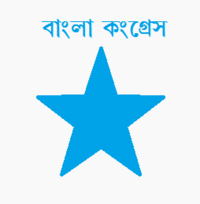Bangla Congress
This article is incomplete because it is pending further input from participants, or it is a work-in-progress by one author. Please comment on this article's talk page to share your input, comments and questions. Note: To contribute to this article, you may need to seek help from the author(s) of this page. |
Bangla Congress বাংলা কংগ্রেস | |
|---|---|
 Party Logo | |
| Abbreviation | BC |
| Leader | Mridul Kumar Chaterjee |
| President | Pratip Sarkar |
| Founder | Bidhan Chandra Roy |
| Founded | January 3, 1956 |
| Preceded by | Indian National Congress |
| Headquarters | Rasbihari Avenue, Kolkata |
| Newspaper | Jatiya Shakti (জাতীয় শক্তি) |
| Student wing | Bangla Students' Congress |
| Youth wing | Youth Congress of Bengal |
| Women's wing | Womens' Congress of Bengal |
| Membership (2019) | 958,841 |
| Ideology | |
| Political position | Centre-right to Right-wing |
| International affiliation | Liberal International |
| Colors | Blue |
| Slogan | "Democracy and Freedom!" |
| Members of NA | 90 / 294
|
| Members of PAs | 258 / 742
|
| Members of MAs | 3,073 / 8,745
|
| Flag | |
 | |
The Bangla Congress (Bengali; বাংলা কংগ্রেস ; BC) is a liberal-conservative and right-wing political party in Bengaala.
Established in 1956, it is the second oldest political party in Bengal, having split from the Bengali regional wing of the Indian National Congress. The party was the strongest electoral force since the first free elections in 1970, up until 1997, when the Ratnapur scandals caused public anger against the party-led government. The party has been the largest opposition party since then. It is one of the two largest parties in Bengaala, with its main rival being the Communist Party of Bengal. The BC is currently led by Mridul Kumar Chaterjee.
History
Split from INC and foundation (1955-1956)
Bengaala was for nearly a decade, rife in instability due to the rising desire for independence among Bengalis from the then-newly independent Indian state. The region was governed by a lieutenant general as an union territory, rather than a full state. A mass demonstration in 1955, spearheaded by both independentists and communists, led to military intervention by the Indian government, due to which a great number of protesters were killed. The ruling party INC} received heavy criticism for using force to quell the protesters. Bengali INC leader Bidhan Chandra Roy denounced the Indian state and the INC as "imperialist", and organised his own faction withing the Bengali regional wing of the INC. Roy was expelled due to anti-party activity in December 1955, and he subsequently formed the Bangla Congress in January 1956. The party was joined by the vast majority of the INC regional wing, as well as many non-communist pro-independence activists. The party adopted its constitution in March 1956, in which it envisioned a free, independent and liberal Bengali state.
Independence struggle (1956-1970)
The BC organised through political clubs and groups, and through trade unions, against the Indian state. The party remained underground for the first five years of 1960s. It appealed to the public through symbolic marches, rallies and newspaper journals, though the independence movement had largely fallen silent since the events of 1955. The party was heavily engaged in mass demonstrations of 1967-68, following the controversial decision of the government to merge Bengal with the neighbouring state of Bihar.